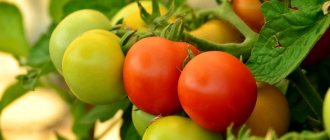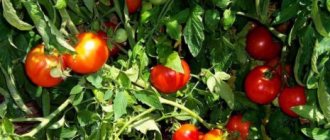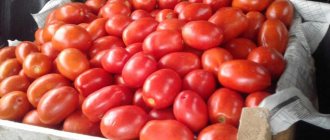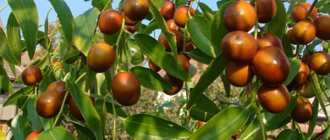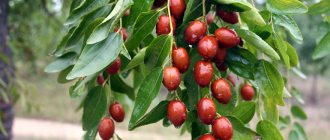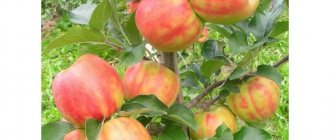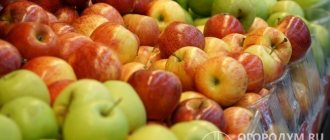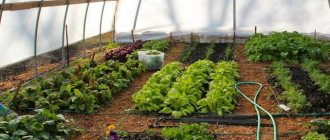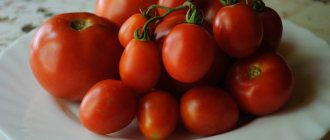Sooner or later, gardeners begin to become interested in the possibility of growing “kolkhoznitsa” melon in open ground and in greenhouses. How realistic is this and what is needed first? Melon is quite demanding of heat and light, but growing the southern berry is quite possible both in open areas and in greenhouses, if you study all the nuances of agricultural technology and do not forget to apply them in practice, taking into account the region of residence and climate characteristics.
Melon Kolkhoznitsa in a section
Description of the variety Kolkhoznitsa
The melon variety Kolkhoznitsa was bred by breeders from the Biryuchekutsk station in the Rostov region. The application for registration was submitted in 1939, and the State Register approved it four years later as melon Kolkhoznitsa 749/753.
Characteristics
Main parameters of the melon variety Kolkhoznitsa:
- Fruit shape. Spherical, up to 20 cm in diameter.
- Pulp. White or yellowish, sweet, juicy, slightly crispy.
- Peel. Hard, but elastic, bright yellow or orange, sometimes with green. But always “mesh”.
- Weight. 0.7-1.4 (maximum 2) kg.
- Taste. Depends on the weather: the hotter and sunnier it is, the sweeter the fruits.
The growing season is short, so melon grows well even in the open ground of the Middle Zone, where summers are short and not hot.
pros
Advantages of melon variety Kolkhoznitsa:
- excellent taste;
- minimum calories;
- good transportability;
- resistance to cold;
- ideal volume: the fruit can be eaten immediately;
- short growing season.
The Kolkhoznitsa variety can be propagated by purchased or independently obtained seeds.
Minuses
Uncritical, insignificant compared to the advantages:
- weak immunity to diseases and pests;
- short shelf life;
- When grown in greenhouses, artificial pollination is required.
The disadvantages did not affect the popularity of the variety: Kolkhoznitsa has been grown by summer residents and merchants for almost 90 years.
Video: recipes for soil mixtures for workaholics
Melon does not tolerate transplanting and picking well; each such procedure postpones the harvest date by a week. Therefore, sow the seeds in individual cups: dry - 2-3 seeds in each, sprouted - one at a time. The volume of the cups depends on the period during which you plan to keep the melons on the windowsill: if 2-3 weeks, then a volume of 150-200 ml (one-time cup) will be enough. If you sow Kolkhoznitsa a month before planting, then take pots with a volume of 300–500 ml.
It is better to tear up and remove peat and paper cups during planting; with insufficient watering, they can turn into a crust that is impenetrable for roots.
Optimal temperature for emergence and further growth: +25… +30 ⁰C. Place melon seedlings in the brightest window. If 2-3 shoots appear in a glass, leave only one of the strongest ones; do not pull the rest by the roots, but pinch them above the ground. Water generously as the top layer of soil dries so that water flows out of the drainage holes. There is no need to feed, since the soil used is fertile, the seedling period is short, there is enough food for the melons.
Chemical composition of vitamins
Kolkhoznitsa melon is not just a tasty, but also a healthy product. The benefits are created due to the variety of composition:
- vitamins – A, C, E, PP, B (1, 2, 3, 5, 6);
- trace elements - potassium, magnesium, zinc, copper, manganese and iodine;
- minerals - iron, calcium, sodium, fluorine, cobalt, sulfur and chlorine;
- other beneficial nutrients: starch, ash, mono- and disaccharides, fatty acids, fiber.
The most “massive”, but devoid of calories, nutrient of Kolkhoznitsa is water, more than 80% of it is in the pulp. The juicy pumpkin pulp easily quenches thirst, simultaneously supplying the body with useful nutrients without a significant influx of calories.
Video: tips from Kherson, professional sowing of melon seeds
Today, the traditional method of growing seedlings is being replaced by a more progressive one, which does not require pots or even soil:
- Lay a standard size cellophane bag on the table and fold it in half so that the width is halved. Or take a strip of film 10–15 cm wide, and the length is equal to twice the number of seeds.
- Place toilet paper on the film in 2-3 layers and moisten it with a room sprayer.
- Stepping back 2–3 cm from the top edge, place the seeds at a distance of 1–2 cm from each other.
- Roll into a tight roll, secure with a rubber band or tape and place in a glass of water. The water should only cover the bottom edge of the toilet paper.
Melon kolkhoznitsa calorie content
The calorie content of fresh Kolkhoznitsa fruits is low - 31-34 kcal per 100 grams. This is less than the Uzbek Torpedo, bananas, mangoes, and many other exotics.
The amount of calories is affected by the degree of ripeness of the fruit: the riper the pumpkin, the sweeter the pulp and the more calories.
Kolkhoznitsa is a variety with the lowest amount of calories among melon varieties.
However, dried or dried pulp has almost ten times more calories.
Characteristics of the nutritional value of the fruit (g per 100 g of pulp): proteins - 0.6, fats - 0.3, carbohydrates - 7.1.
Feeding methods
Feeding the melon once every half month will ensure that it is saturated with the necessary macroelements and will create conditions for proper development. The first procedure is carried out 2 weeks from the day the seedlings are planted in the ground. Before the ovaries form, the crop must be fertilized with nitrogen. Urea, ammonium sulfate, ammonium nitrate - fertilizers rich in this macroelement are not difficult to find and buy. They can be applied either dry, distributed over the bed after loosening, or diluted with water.
Important! Only a weak concentration solution, no more than 15 g of product per 10 liters, will benefit the plants.
Beneficial features
The beneficial properties of melons have been known for decades.
Overall Impact
Here are the benefits of melon of the Kolkhoznitsa variety:
- Fiber solves the problem of constipation and facilitates the digestion of heavy and fatty foods.
- The juicy pulp perfectly quenches thirst, at the same time washing the kidneys and urinary tract.
- Melon is distinguished by an abundance of enzymes that are beneficial for digestion.
- Carbohydrates improve brain function by promoting the production of serotonin. This hormone of happiness helps to get out of depression, overcome stress or fatigue.
- Removes waste, toxins and heavy metals. Thus, it neutralizes the effects of poisoning, simultaneously ridding the body of extra pounds.
- The pulp contains a lot of iron - this is an element useful for people prone to anemia.
Magnesium calms the nerves, calcium strengthens the skeleton, hair and nails.
Who is the Kolkhoz Woman useful for?
The sweet, vitamin-rich pulp of Kolkhoznitsa is a must-have food product for children. The presence of folic and ascorbic acids, beta-carotene makes it useful for pregnant women. The number of calories has almost no effect on body weight. The most useful melon component for men (with a minimum of calories) is the seeds. Two or three seeds per season daily will help maintain potency.
Collective farmer for weight loss
The collective farmer with her symbolic amount of calories is a salvation for people on a diet.
- Those who like to count calories are recommended to consume it as a healthy independent dish.
- This is a healthy second breakfast with a minimum of calories.
- You can eat a couple of pieces in the evening, but no later than 2-3 hours before bedtime and no more than 100 g of pulp at a time. To “increase” the amount of food and, as it were, reduce calories, the melon is cut into small pieces.
- More than 80% of melon is water. To quench your thirst, it is healthier to eat Kolkhoznitsa (it has fewer calories) than the sweeter Uzbek Torpedo.
Bright sweet pieces will soften the severity of your diet, give you strength in the fight against calories and lift your spirits.
Helpful ally of beauty
The collective farmer is loved by cosmetologists and everyone who is concerned about their own appearance.
Beta-carotene, which is abundant in the pulp, is beneficial for the skin: nourishes, softens, improves color.
A pulp mask also removes wrinkles, freckles or pigmentation. Juice is a useful addition to water for rinsing hair: dandruff disappears, hair shines and becomes stronger.
How to properly consume Kolkhoznitsa
Melon pulp, including the Kolkhoznitsa variety, is a useful ingredient only if consumed correctly.
It is served for dessert after the main courses have been eaten.
It does not combine with meat, dairy, fermented milk products, other vegetables or fruits.
It is better to eat melon in the summer, when its beneficial properties are most pronounced.
Sowing immediately to a permanent place, soil preparation, planting scheme
Residents of the south, as well as owners of greenhouses and those who have the opportunity to approach their plantings at least twice a day to cover them in the evening and remove temporary cover in the morning can grow Kolkhoznitsa without seedlings. It is recommended to prepare the soil for melons in the fall, since phosphorus fertilizers need to be applied, and they take a very long time to dissolve. If you add superphosphate in the spring, it will be in an easily digestible form by the time the melons ripen, although it is needed throughout the entire growing season.
Superphosphate granules can be used to fertilize perennial crops throughout the warm season, but for melons that grow for only one season, it is applied in advance, in the fall.
Fertilizers for planting melons per 1 m² of bed:
- In autumn - a tablespoon of superphosphate and potassium fertilizer, a bucket of humus.
- In spring - 0.5 liters of wood ash, a bucket of humus or compost. Organics can be replaced with 1 tbsp. l. ammonium nitrate or urea.
For looseness, it is not necessary to sprinkle sand; you can use small pieces of bark, thin twigs, leaves, hay dust and other plant debris, which will also enrich the soil by rotting.
The soil on the melon patch should be loose, allowing air and moisture to pass to the roots.
In regions of risky farming with cool and rainy summers, as well as in areas with close groundwater, it is customary to make high beds. Under a layer of soil of 20 cm, “pillows” of approximately the same thickness are placed from natural materials: grass, branches, household waste, sawdust, etc. In this case, the melons will be raised above the garden level, will be better warmed by the sun, and will dry out faster after rains. Many people grow melons in barrels and boxes emptied after growing cabbage seedlings.
Contraindications
Kolkhoznitsa is undoubtedly a useful product, but its consumption has limitations.
Stop factors for melon consumption:
- diabetes mellitus (pumpkins are relatively high in calories);
- gastrointestinal problems;
- gallstones or kidney stones;
- breast-feeding.
Melon should not be eaten simultaneously with milk, honey, alcohol or on an empty stomach.
Melon is contraindicated for children under one year of age: it can cause flatulence or digestive problems.
How to choose ripe and sweet melon when buying
We will describe several ways to choose the right melon during visual inspection:
- you cannot buy melons along highways, since its rough peel can absorb carcinogens;
- You only need to buy a whole fruit, and not a cut or damaged one: due to the violation of the integrity of the cover, the pulp will accumulate pathogenic bacteria;
- when tapping a melon, a dull sound should come out, not a ringing one;
- a pleasant aroma should come from the vegetable, but if there is no smell, then the plant is most likely overfed with nitrogen or it is not ripe;
- when pressed, the rind of a ripe melon will spring back;
- If, when you run your finger along the melon, grooves remain, then it is ripe; if not, it is overripe, and the places where pressure is applied will be bitter.
Collective farmer melon growing in open ground
Melon is a fastidious crop that is accustomed to the climate of the southern regions. But its cultivation is also possible for Central Russia. Let's look at how to grow the Kolkhoznitsa variety in open ground.
How to plant correctly
The collective farmer is planted in open ground, taking into account the climate: seedlings or seeds (warm regions), only seedlings (cool regions).
Melon requires special conditions:
- sunny, spacious, wind-protected areas are suitable;
- soil – loam or other light soil;
- swampiness is excluded, dry areas are needed;
Landing rules:
- In the fall, future planting sites are supplied with fertilizers, in the spring - with ash, humus, compost or urea.
- The soil is “loosened” with sand.
Planting of Kolkhoznitsa is possible when the air temperature remains stable at a minimum of +11°C.
- The seedlings are carefully removed from the cups in which they grew. Make sure that the roots are not damaged.
- The plant should be planted at the same depth.
- The distance between the holes is 80-90 cm. They are sprinkled with sand.
- For the first seven to eight days, the seedlings are covered with a common film or plastic container, each seedling.
- Water with warm water.
When the temperature drops below +5°C, the bushes are covered.
Watering and fertilizing
The melon of this variety loves warmth, excess moisture is unacceptable - it is a useful partner for the fungus, to which the Kolkhoznitsa variety has no immunity.
To prevent fungus from appearing on the plant, water the melon with warm water so that it does not get on the leaves and stems.
Irrigation features:
- Once the pumpkins have set, the soil should be consistently moist.
- Grown fruit bushes are watered weekly.
- Watering is stopped when there are 15-20 days left before the crop ripens.
The soil between the rows is loosened three times during the season.
Feeding algorithm:
- First. 15 days after planting the seedlings or when two leaves appear on the seedlings. Aqueous solution of chicken manure (1:13).
- Second. After another 15-20 days. A mixture of superphosphate, potassium salt, ammonium nitrate - 60:15:20 g per 10 liters of water. Each bush requires half a liter of mixture.
- Third. In three weeks. Aqueous solution of chicken manure (1:13).
Fertilizers should not get on the pumpkins, otherwise they will taste bitter.
The mixture can be purchased ready-made or replaced with ash, which is scattered near the fruit, loosened and watered.
Formation of bushes
To form bushes in the garden bed, use any of two methods:
- To create a vertical (trellis) crop, a wire frame is stretched to a height of 2 m. The lower end of the rope is loosely fastened to the plant. When the bushes grow, they will be pulled along the rope.
- In conventional cultivation, the main stem is pinched above the main 3rd or 4th leaf, leaving the two strongest ones.
Keep in mind that pumpkin flowers grow exclusively on side shoots. The bushes are pinched when the ovaries reach the size of a chicken egg.
Prevention measures
The number one enemy of the Collective Farmer is fungus. To prevent or destroy it, plants are treated with fungicides twice: on the eve of flowering and when the ovaries begin to grow.
A useful method is to treat the crops with an aqueous solution of tobacco powder or laundry soap.
To prevent the pumpkins from rotting, place a piece of plastic, plywood or other hard material under each one.
Timing and definition of maturation
The standard planting period for the variety is May. The Kolkhoznitsa melon ripens in the summer, by the end of July - August.
The ripeness of pumpkins is determined simply:
- the stalk is dry, easily torn off;
- the peel is bright, dry, and exudes a pleasant aroma;
- When a pumpkin is slapped, a dull sound is heard.
In cool regions, pumpkins of this variety may not ripen, but they are still harvested so as not to rot. They ripen in a dry, dark room at a temperature of 16-19°C.
Harvesting and storage
To preserve the taste and beneficial conditions of the Kolkhoz, the harvest is harvested and stored according to the rules:
- Before storing, a ripe melon is laid out on the ground in one layer for 12-15 days, turning over after 4-5 days.
- Melons need delicate handling: they should not be dropped or stacked. Any damage starts the process of rotting.
- Ripe melons are hung - in a net or tied by the stalk. Or store in a box with soft bedding.
- Unripe fruits (with a tail of 4-6 cm) ripen, maintaining beneficial conditions for three to four months.
Regardless of the degree of melon ripeness, long-term storage of the crop requires an appropriate microclimate: humidity - 75-80%, temperature - just above zero degrees.
Ripe whole Kolkhoznitsa fruits in the refrigerator retain their beneficial properties for up to five days, cut ones - for a maximum of three days.
Harvest and storage
Unlike watermelons, melons clearly signal that it is time to remove them from the bush. The skin turns yellow, the berries begin to exude a characteristic sweet aroma. The collective farmer can be ripened at home on the window, under the bed or in another place, as long as it is dry there. Cut the fruits with a “tail”, that is, leave a stalk 3–5 cm long.
Melons are stored hanging in a cool room, large quantities are collected in braids or garlands
Handle the melons carefully; do not throw them, drop them, or stack them on top of each other in several layers. Any damage to the crust: a dent, a bruise, a crack, will lead to rotting of the fruit. Completely whole melons can be stored in the basement until the New Year, hanging each one separately by its tail or in a net. Storage temperature: +1... +3 ⁰C, humidity - 70–80%.
Video: tasting of eight varieties of melons, including Kolkhoznitsa
The main purpose of Kolkhoznitsa, like all melons, is for table use, that is, for fresh consumption. However, if you have harvested a rich harvest, there is no storage space or there are a lot of damaged fruits, then treat the melons as you would with ordinary berries. From their slices you can make preserves, compotes, jams, jams, and candied fruits. Melon is pickled, dried, frozen.
In addition to a large amount of vitamins and microelements, this berry contains folic acid, which improves hematopoiesis and reduces the proportion of bad cholesterol. Melon lovers suffer from fewer colds and have stronger immunity. In addition, this berry is a good anti-stress agent, reduces anxiety, and improves mood. Of course, melon has diuretic properties and helps with kidney diseases.
Melon marmalade - a beautiful and tasty delicacy
Regionality
Depending on the region, melons ripen differently, but in the north it is more difficult to achieve a harvest.
Growing in the Urals
Due to the short and cold summer, melon can only be planted in a greenhouse. But if you follow the growing technique, the fruits turn out sweet.
Moscow region
Also not the best place for a collective farmer. It is necessary to plant seedlings; the seeds are sown in mid-April. At night, seedlings need to be covered. Constant feeding is also required.
In Siberia
Oddly enough, in Siberia, melons grow not only in greenhouses. For them, you can prepare warm beds from rotted manure, plant debris, and nitrogen fertilizers. On top is a layer of fertile soil (20-25 centimeters). Protect from frost with smoke from fires around the beds or with the drug Epin.
Reviews
- Anastasia, 56 years old: “I always plant only one variety of melons in my home melon patch - “Kolkhoznitsa”. My whole family loves this ancient and tried-and-true fruit. I buy its seeds in garden stores and they have never let me down. I always reap a good harvest.”
- Zhanna, 42 years old: “I constantly grow watermelons and melons in my garden. One of my favorite varieties is the Kolkhoznitsa melon. I love its juicy pulp and seeds. They can be dried and eaten in winter. This fruit should be eaten alone, without other food or as a sweet dish. But it’s better to wait an hour after your last meal. If it is eaten with milk or alcohol, there is a risk of poisoning.”
- Kirill, 59 years old: “We live in a private house and have a large garden, so we plant absolutely everything on it. A separate area was allocated for melon growing. Since the whole family loves to eat melons, we already have several proven varieties that never fail and give a rich harvest. For the fifth year in a row we have been planting “Collective Farmer”. This mid-season variety produces vigorous shoots and then blooms profusely. This plant grows well, and spherical yellow fruits grow on it already on the 80th day. From one plant you can collect up to 5 kg of fruit. When you cut into a melon, you can see the white flesh inside it, and when you eat it, it has a crunchy feel. The ripe fruit simply smells divine and is very tasty. My family preserves it in slices and makes jam or marmalade. From several bushes we manage to eat enough of it and still preserve enough for the winter.”
Agrotechnical measures
Agrotechnical measures for caring for melon include watering, fertilizing and ensuring optimal temperature conditions. Melon is a heat-loving plant, so the optimal temperature for it is +25-30 degrees. This is what greenhouse growing is designed for. When such conditions are created, the seeds will germinate quickly; at higher or lower temperatures the process will slow down. For the growing season, dry air and +28-30 degrees are exactly the conditions under which the plant will give the expected tasty and aromatic result.
